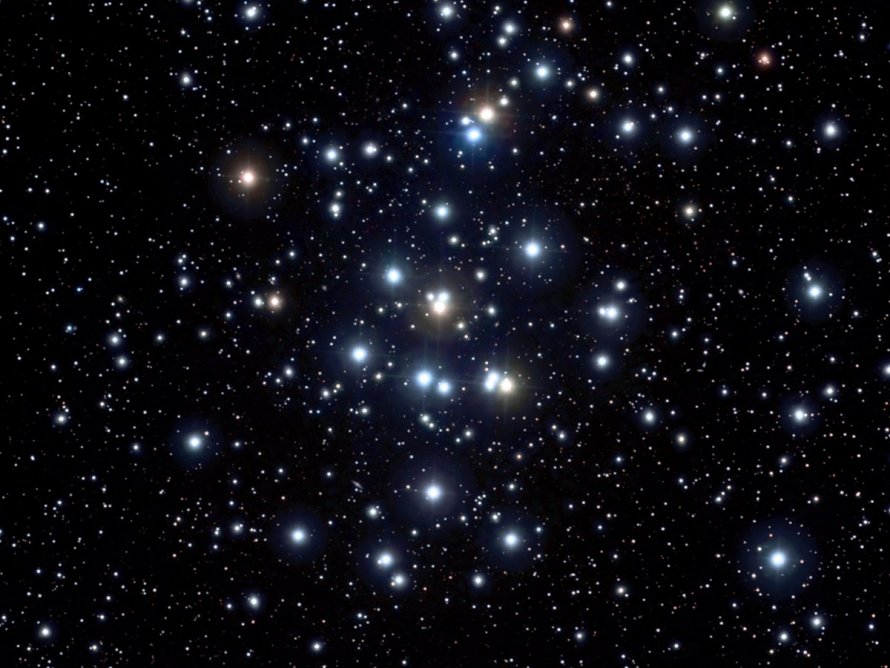M44 (NGC 2632) - Beehive Cluster
Messier 44 (NGC 2632), also known as the Beehive Cluster, is an open cluster located in the constellation Cancer, in the Orion Arm of the Milky Way Galaxy in the Local Group of galaxies. M44 is 610 light years away from Earth.
M44 is best viewed during early spring, is magnitude 3.7, and can be viewed with naked eye. M44 is 95' in apparent size. For reference, the full moon is 30'.
Observing difficulty: Easy
- Name:
- Beehive Cluster
- Alt name:
- Presepe
- Type:
- open cluster
- Constellation:
- Cancer
- NGC or IC:
- NGC 2632
- Magnitude:
- 3.7
- Viewing:
- naked eye
- Size:
- 95'
- Distance (light years):
- 610 LY
- RA:
- 8h 40.1m
- Dec:
- 19 59'
- Season:
- early spring
- Milky Way location:
- Orion Arm
- Galaxy group:
- Local Group
- Messier Marathon #:
- 27
* The naked eye can see up to magnitude ~7-8 objects under ideal dark sky conditions.
Unraveling the Secrets of the Beehive Cluster
Messier 44, commonly referred to as the Beehive Cluster, or Praesepe (Latin for "manger"), is an open star cluster in the constellation Cancer. The cluster serves as a significant research object for understanding stellar evolution and cluster dynamics. This article provides an in-depth examination of the Beehive Cluster's historical context, physical attributes, and astronomical relevance. Additionally, it outlines the ease of locating and viewing M44 from Earth.
Historical Background
The Beehive Cluster is one of the few objects in Messier's catalogue visible to the naked eye from Earth. Known since antiquity, ancient astronomers referred to it as the "cloudy star." It wasn't until Galileo's observations in 1609, with the newly invented telescope, that it was revealed to be a cluster of stars. Charles Messier cataloged it as M44 in 1769 as part of his effort to compile a list of objects that could be mistaken for comets.
Physical Characteristics and Magnitude
M44 is an open cluster located at a distance of approximately 577 light-years from Earth, in the middle of the constellation Cancer. It spans an impressive 95 arcminutes, which is more than three times the size of the full Moon's disk, translating into a physical size of about 39 light-years.
The Beehive Cluster is home to about 1000 confirmed members, although only a few dozen are bright enough to be seen through a small telescope. The brightest stars in the cluster are hot and blue, with magnitudes between 6 and 7, and several red giants are also present. The overall magnitude of the cluster is approximately 3.7, making it easily visible to the naked eye under good conditions.
Astronomical Importance
M44 provides astronomers with a valuable opportunity to study a relatively nearby, well-populated open star cluster. Its member stars, formed from the same molecular cloud, share a similar age and composition. This homogeneity enables the study of stellar evolution processes, where differing stellar masses play a critical role.
Finding and Observing M44
M44 is one of the easiest Messier objects to locate. Its location in the constellation Cancer positions it nearly midway along the ecliptic line between the Gemini Twins to the west and Leo's Sickle to the east. Under dark sky conditions, M44 is visible to the naked eye as a faint cloud. From less ideal locations, binoculars or a finder scope often reveal it as a nebulous patch.
When observed through a small telescope, the Beehive Cluster reveals its true nature. Dozens of stars become visible, especially when using a low power eyepiece to cover the cluster's large apparent size. Since M44 covers more than one and a half degrees of sky, it's best viewed with binoculars or a wide-field telescope, which reveal its many stars set against a richer star field.



